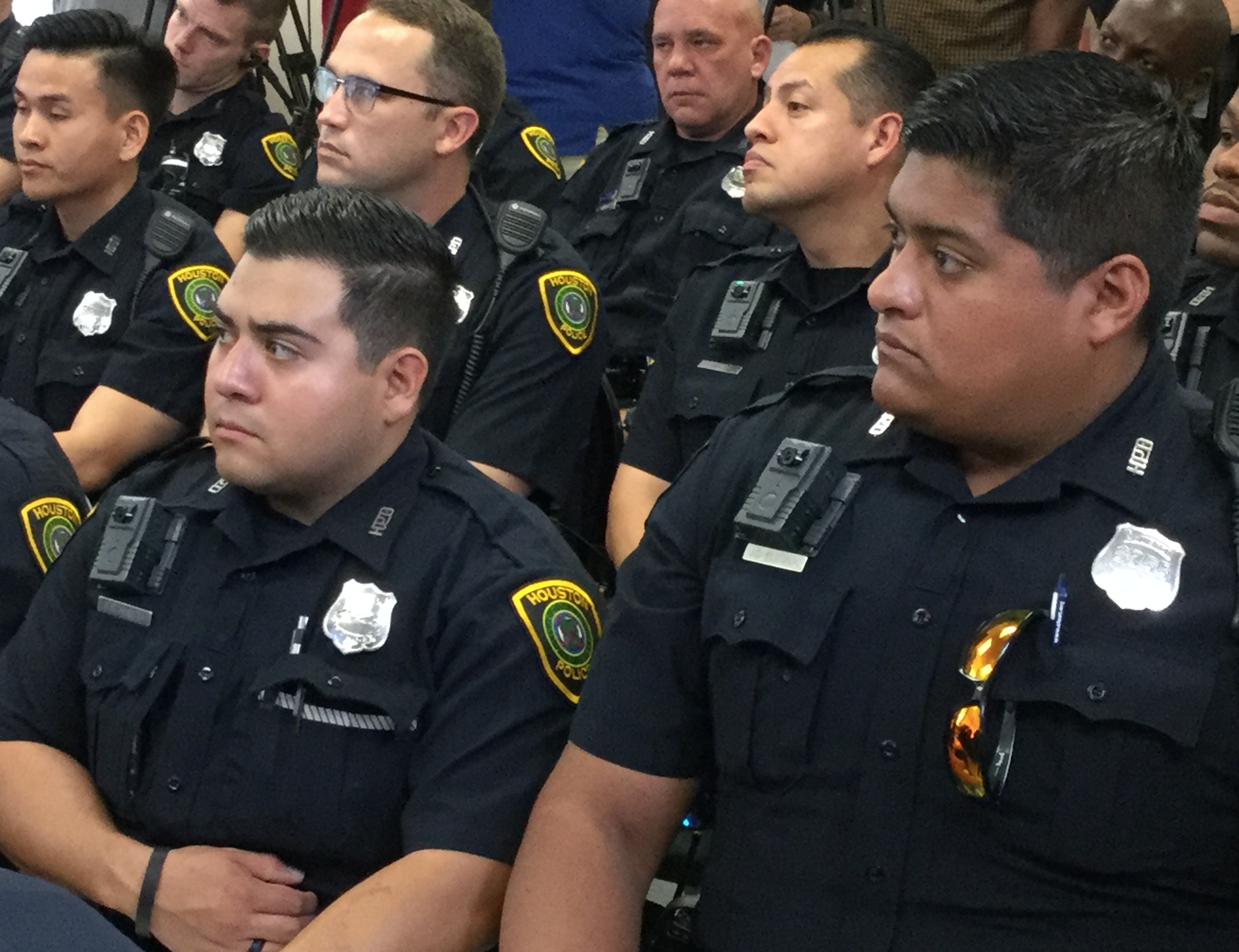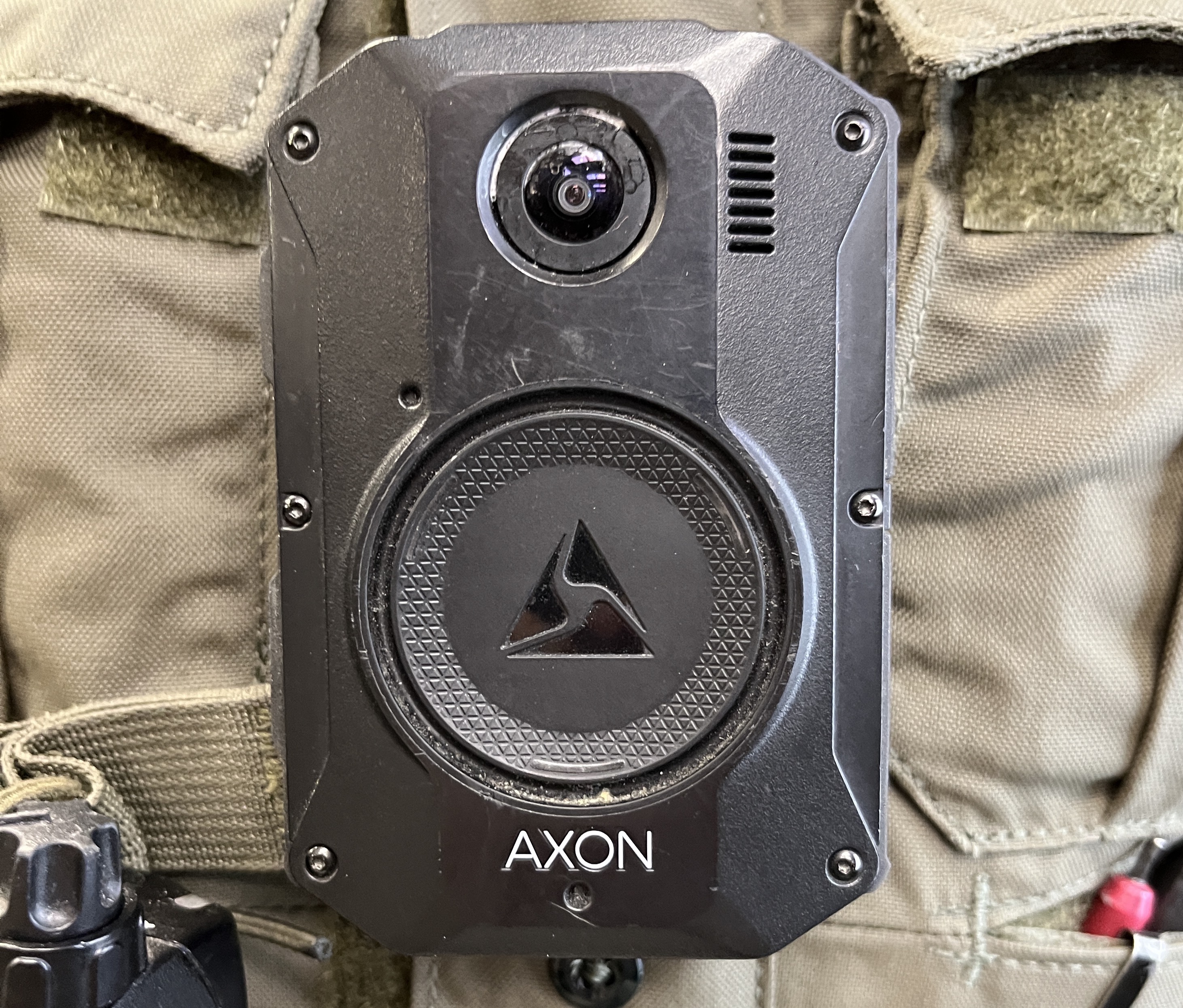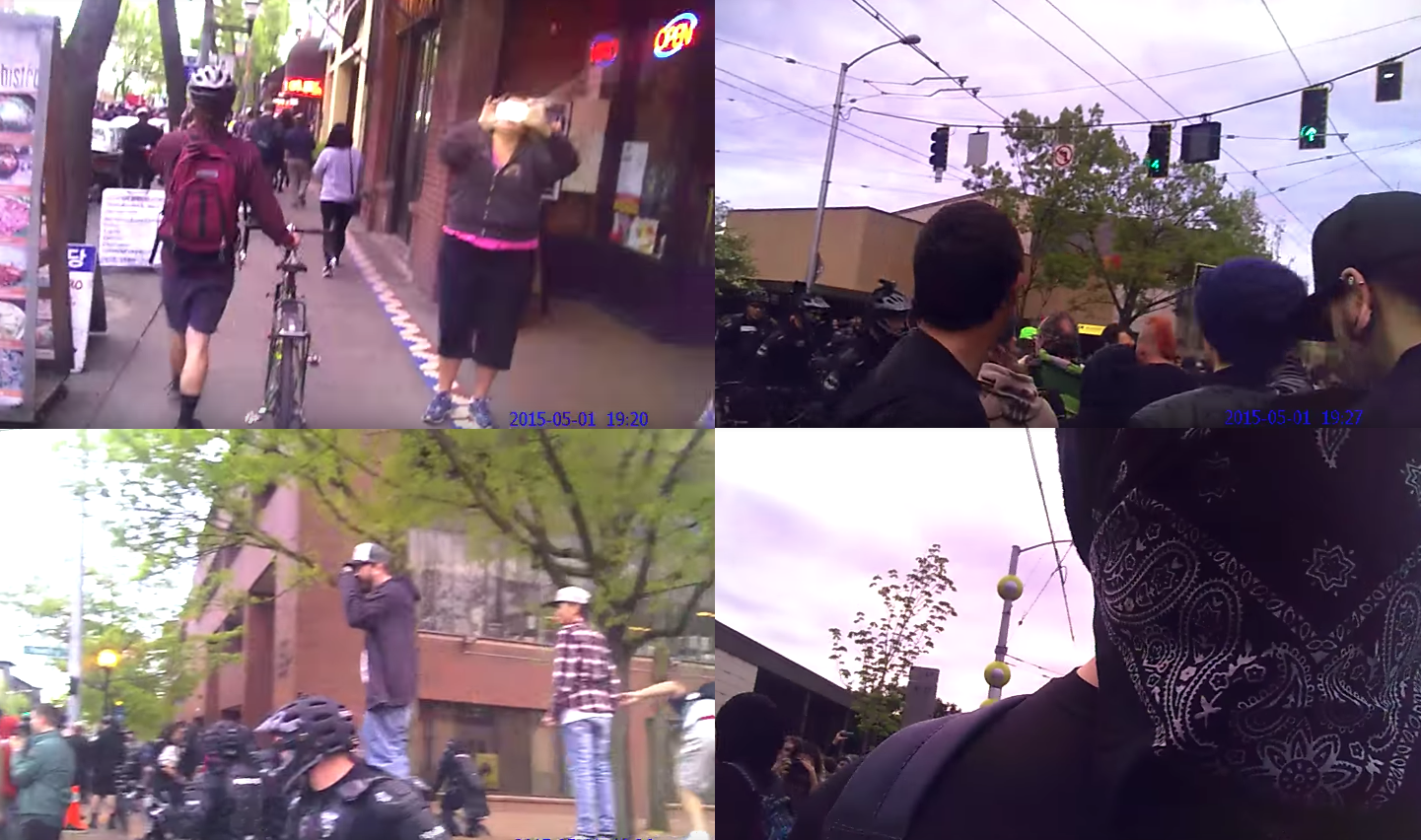
Body-worn cameras
Reformers often tout police use of body-worn cameras (BWCs) as a way to prevent law enforcement misconduct. But, far too often, this technology becomes one more tool in a toolbox already overflowing with surveillance technology that spies on civilians. Worse, because police often control when BWCs are turned on and how the footage is stored, BWCs often fail to do the one thing they were intended to do: record video of how police interact with the public. EFF opposes BWCs absent strict safeguards.
How Body-Worn Cameras Work

Body-worn cameras are small devices which can be clipped onto a police officer’s uniform or worn as a headset and turned on to record video and audio of law enforcement encounters with the public. The video is often saved with time and date stamps and GPS coordinates. Some body cameras offer real-time video streaming. Others offer Bluetooth trigger options for automatic recording. Agencies can select inputs that trigger body-worn cameras to automatically turn on, such as turning on a cruiser’s sirens or driving over a certain speed, or when nearby dashboard or body cameras are switched on. A new wireless holster sensor can activate cameras when a gun is drawn. Footage is uploaded to external databases maintained by police agencies or third party vendors. At least one company has been developing a body-worn camera that offers live facial recognition.
What Kinds of Data Body-Worn Cameras Collect
When police turn on body-worn cameras, they collect video and audio footage of people in the vicinity of the officer. Some also include date and time stamps as well as GPS coordinates. The footage often captures faces, which can be analyzed by face recognition technology.
How Law Enforcement Uses Body-Worn Cameras

Many states mandate the statewide use of body-worn cameras by law enforcement officers interacting with the public, though several of these states have a phased implementation. Nationwide, EFF’s Atlas of Surveillance has catalogued more than 4,517 police departments using body-worn cameras.
Police can collect video footage when they decide to stop and frisk someone, search property, conduct a car stop or a chase, conduct a witness interview, issue a summons, or make an arrest.
In 2016, The Leadership Conference on Civil and Human Rights issued a detailed scorecard comparing the wide variations in body-worn camera practices across the county. The scorecard was updated in 2017. Some police departments make their policies easily accessible, but others do not. Some limit officer discretion on when they should and should not record, while others do not. Some address personal privacy concerns, prohibit pre-report viewing by officers, limit retention of footage, protect the footage from tampering and misuse, allow individuals filing complaints to access footage, or limit use of biometric technologies such as facial recognition. But many do not.
According to the 2017 data, 52 of 68 police departments in major cities have body-worn camera programs with policies in place, with 49 making them available on their department websites. At least four departments—Cincinnati, Las Vegas, Parker (Colorado) and Washington, D.C.—provide the individuals who were recorded access to all of the footage. At least 12 departments prohibit officers from reviewing footage before filing initial written incident reports for some critical incidents, like officer shootings. Baltimore, Baltimore County, Boston, Cincinnati, Montgomery County (Maryland), Parker, and Seattle limit the use of biometric technologies with camera footage.
Who Sells Body-Worn Camera Technology
Many police departments use body-worn cameras made by Axon (formerly Taser), which provides free cameras and sells data storage services. Other vendors include Aventura, Black Mamba, BrickHouse Security, Brimtek, COBAN, Data911, DEI, Digital Ally, FlyWIRE, Global Justice, GoPro, HauteSpot, HD Protech, Kustom Signals, L-3 Mobile-Vision, Law Systems, Marantz Professional, Martel, Motorola, Panasonic, Patrol Eyes, Paul Conway, Pinnacle, PRG, Primal USA, PRO-VISION, Reveal Media, Safety Innovations, Safety Vision, Titan, Utility Inc, VIEVU, VP360, WatchGuard, Wolfcom, Zepcam, and Zetronix.
In addition to selling body cameras, some vendors also provide data storage for the footage. For example, body-worn camera maker VIEVU owns the cloud-based service VERIPATROL, and Axon owns the cloud-based service company Evidence.com. Some companies, such as Utility Inc. and Motorola, partner with Amazon Web Services for storage of body camera footage.
Some body-worn camera providers, such as Axon, ask police departments to sign contracts permitting the footage to be stored in a proprietary system. Attorneys for criminal defendants may have to agree with Axon’s restrictive terms of service to access documents produced in judicially mandated discovery.
Threats Posed by Body-Worn Cameras
Body-worn cameras are a threat to privacy, protest, and racial justice and have the potential to massively expand the power of government to record video and audio of people going about their lives in both public and private places. The footage might be kept indefinitely, routinely subjected to face surveillance, and used in combination with other surveillance technologies, like stationary pole cameras. Thousands of hours of body-worn camera footage can be algorithmically analyzed, converted into metadata, and stored in searchable databases. Police use of body-worn cameras at protests could discourage people from making their voices heard.
Given the many ongoing inequities in our criminal justice system, body-worn cameras disproportionately impact people of color, immigrants, and other vulnerable groups. They may also discourage people from seeking out officers for assistance, further undermining community trust in law enforcement. Without the necessary safeguards in place, body-worn cameras expand police surveillance of communities without improving police accountability.
When police enter a citizen’s home with a body-worn camera, they may pick up video and audio footage of innocent private domestic activity. This could include children, people in various states of undress, or even victims of domestic violence or sexual assault. Some police departments have policies that protect vulnerable individuals from being recorded without their informed consent, while others offer only vague guidance on personal privacy issues. Some policies don’t address these concerns at all.
Footage can be saved for years, putting it at risk of data breach, employee misuse, and long-term surveillance of the public. So departments must adopt appropriate data retention and security policies. Conversely, retention policies should be long enough (months) to allow victims or the public to access videos involved in use of force incidents, misconduct, or other complaints. Often, police can immediately access video but the recorded civilians (and their attorneys) cannot. For example, in State vs. Robinson, the court held that New Jersey state law did not require production of existing body-worn camera footage at a pre-trial hearing. In some instances, footage may be made available to the public without blurring bystander faces, raising privacy concerns.
The New York Times created an excellent explainer showing how a narrative may be interpreted differently depending on the perspective of the footage (from an officer’s body camera as opposed to a bystander’s phone camera) and whether the footage contains audio.

Additionally, police often have the discretion to release portions of video selectively and at specific times as a public relations strategy to insulate themselves from claims of misconduct. This has been done with surveillance footage. For example, after unarmed black teenager Michael Brown was fatally shot by a white Ferguson police officer, the Ferguson Police Chief released a surveillance video showing the teen appearing to leave a store with an unpurchased box of cigarillos. Later it was revealed that the officer who shot Michael Brown was unaware of the earlier incident. Likewise, the Chicago Police Department delayed for 13 months the release of its footage of officers killing Laquan McDonald.
If police can decide which encounters to record and when to turn off cameras, this will circumvent the oversight the cameras are meant to provide. For example, when police are given discretion over when to turn on body-worn cameras, they often neglect to do so. Even when police are required to use body-worn cameras for certain types of stops or encounters, compliance with these rules can be low. Failures of police to turn on their cameras during use-of-force incidents don’t always result in disciplinary action. For example, Albuquerque’s Civilian Police Oversight Agency (CPOA) found that officers violated the department’s body-worn camera recording rules more than they violated any other policy. When the CPOA sent the police chief notice of violations of the on-body camera recording policy, the chief disagreed with the agency’s conclusions and no disciplinary action was imposed.
Many police departments allow officers to review footage before making initial statements to investigators about use of force or incidents subject to civilian complaint. This gives officers the chance to tailor their stories to the video evidence, and even help some officers to lie in a way consistent with the video. It also makes it possible for police to engage in a fishing expedition about the civilians they stop, searching for additional crimes that they did not previously detect.
EFF’s Work on Body-worn Cameras
We have consistently opposed body-worn cameras absent strict rules to ensure they protect privacy and advance police accountability. These include:
- Mandated activation. Officers must turn cameras on at the start of all investigative encounters with civilians, and leave them on until the encounter ends.
- No political spying. Officers must not use cameras to gather information about people exercising their First Amendment rights.
- Retention of footage. It must be stored for a few months, so injured civilians have time to request footage, and then promptly destroyed to prevent long-term surveillance.
- No face surveillance. That technology is too dangerous for police to use, especially in connection with body-worn cameras.
- Officer review of footage. If the footage depicts use of force and an episode subject to civilian complaint, the officer must make an initial statement before reviewing the footage.
- Public access to footage. If it depicts a person, they must have access. If it depicts force, everyone must have access. If another person seeks footage of another type of police misconduct, a court must weigh the privacy costs of disclosure against the police accountability benefits.
- Rigorous enforcement. Footage collected in violation of these rules must be excluded from court. Footage not collected in violation of these rules should create an evidentiary presumption that the missing footage would have helped the civilian.
- Community control. Police must not deploy body-worn cameras, unless the city council votes to approve them, after community input. Many communities will say “no.
In 2015, we opposed LAPD’s policies for body-worn cameras because the LAPD failed to adopt necessary safeguards about camera activation, public access to footage, officer misuse of footage, and face recognition. We also weighed in on state legislation, including opposing California’s A.B. 1940, which would have allowed officers to view footage before writing their statements. In 2017, along with the ACLU of California and the Bay Area chapter of the Council on American-Islamic Relations, we sent a letter to the Santa Clara County Board with suggestions on ways to improve their proposed policy for the Sheriff’s use of body-worn cameras. In 2020, we recommended safeguards to the federal Justice in Policing Act's section on body-worn cameras. We supported a California law (A.B. 1215) that placed a three-year moratorium on use of face surveillance and other biometric surveillance technologies on footage collected by body-worn cameras. We successfully enforced this moratorium in San Diego.
Suggested Additional Reading
Body-worn Cameras Laws Database (National Conference of State Legislatures)
Body-worn Camera Scorecard (The Leadership Conference on Civil and Human Rights)
Policing Body Cameras: Policies and Procedures to Safeguard the Rights of the Accused (National Association of Criminal Defense Lawyers)
Police Body-mounted Cameras with Right Policies in Place, A Win for All (ACLU)
No Police Body Cams Without Strict Safeguards
The Justice in Policing Act Does Not Do Enough to Rein in Body-Worn Cameras
California: No Face Recognition on Body-Worn Cameras
Victory: San Diego to Suspend Face Recognition Program, Limits ICE Access To Criminal Justice Data
Most recently updated October 1, 2023